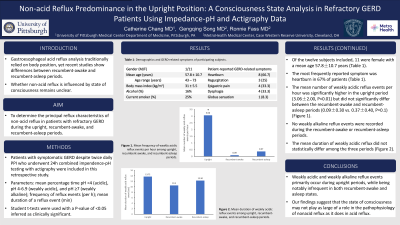Tuesday Poster Session
Category: Esophagus
P3233 - Non-Acid Reflux Predominance in the Upright Position: A Consciousness State Analysis in Refractory GERD Patients Using Impedance-pH and Actigraphy Data
Tuesday, October 24, 2023
10:30 AM - 4:00 PM PT
Location: Exhibit Hall

Has Audio

Catherine Chang, MD
University of Pittsburgh Medical Center
Pittsburgh, PA
Presenting Author(s)
Catherine Chang, MD1, Gengqing Song, MD2, Ronnie Fass, MD3
1University of Pittsburgh Medical Center, Pittsburgh, PA; 2MetroHealth Medical Center, Case Western Reserve University, Cleveland, OH; 3MetroHealth System, Case Western Reserve University, Cleveland, OH
Introduction: Analysis of gastroesophageal acid reflux traditionally relied on body position, yet recent studies show differences in reflux characteristics between recumbent-awake and recumbent-asleep periods, and the influence of consciousness. Non-acid reflux accounts for one-third of all reflux events, yet its relation to consciousness has not been evaluated. The purpose of this study was to determine the principal reflux characteristics of non-acid reflux during the upright, recumbent-awake, and recumbent-asleep periods in patients with refractory gastroesophageal reflux disease (GERD) on proton pump inhibitor (PPI) therapy.
Methods: Patients with documented GERD at baseline and persistent reflux symptoms despite PPI twice daily therapy were included. All subjects were at least 18 years old and underwent combined impedance-pH monitoring concomitantly with actigraphy. Parameters analyzed included: mean duration of sleep time (min); mean percentage total time pH < 4 (acidic), pH 4-6.9 (weakly acidic), and pH ≥7 (weakly alkaline); frequency of reflux events (per h); and mean duration of a reflux event (min). Student t-tests were used to analyze continuous variables, and a P-value of < 0.05 was inferred as clinically significant.
Results: Twelve subjects (11 female, mean age 57.8±10.7 years) were included. The percent total time pH ≥7 was significantly higher in the upright period (11.23±19.40, P< 0.05) compared to the recumbent-awake period (1.52±4.72) with no significant difference between recumbent-awake and asleep periods (0.38±0.90, P=0.3). The mean number of weakly acidic reflux events per hour was significantly higher in the upright period (3.06±2.00, P< 0.01) compared to the recumbent-awake and recumbent-asleep periods (0.09±0.30 vs. 0.37±0.40, P=0.1). There were no weakly alkaline reflux events recorded during either recumbent-awake or asleep periods. The mean duration of weakly acidic reflux did not statistically differ among the three periods. Symptomatic non-acid reflux was reported in 25% of patients during the upright period.
Discussion: Weakly acidic and weakly alkaline reflux events primarily occur in upright periods, while being notably infrequent during recumbent-awake and asleep states. Our study provides valuable insight into the behavior of non-acid reflux in relation to varying states of consciousness, and highlights its predominance as an upright phenomenon less influenced by consciousness compared to acid reflux.
Disclosures:
Catherine Chang, MD1, Gengqing Song, MD2, Ronnie Fass, MD3. P3233 - Non-Acid Reflux Predominance in the Upright Position: A Consciousness State Analysis in Refractory GERD Patients Using Impedance-pH and Actigraphy Data, ACG 2023 Annual Scientific Meeting Abstracts. Vancouver, BC, Canada: American College of Gastroenterology.
1University of Pittsburgh Medical Center, Pittsburgh, PA; 2MetroHealth Medical Center, Case Western Reserve University, Cleveland, OH; 3MetroHealth System, Case Western Reserve University, Cleveland, OH
Introduction: Analysis of gastroesophageal acid reflux traditionally relied on body position, yet recent studies show differences in reflux characteristics between recumbent-awake and recumbent-asleep periods, and the influence of consciousness. Non-acid reflux accounts for one-third of all reflux events, yet its relation to consciousness has not been evaluated. The purpose of this study was to determine the principal reflux characteristics of non-acid reflux during the upright, recumbent-awake, and recumbent-asleep periods in patients with refractory gastroesophageal reflux disease (GERD) on proton pump inhibitor (PPI) therapy.
Methods: Patients with documented GERD at baseline and persistent reflux symptoms despite PPI twice daily therapy were included. All subjects were at least 18 years old and underwent combined impedance-pH monitoring concomitantly with actigraphy. Parameters analyzed included: mean duration of sleep time (min); mean percentage total time pH < 4 (acidic), pH 4-6.9 (weakly acidic), and pH ≥7 (weakly alkaline); frequency of reflux events (per h); and mean duration of a reflux event (min). Student t-tests were used to analyze continuous variables, and a P-value of < 0.05 was inferred as clinically significant.
Results: Twelve subjects (11 female, mean age 57.8±10.7 years) were included. The percent total time pH ≥7 was significantly higher in the upright period (11.23±19.40, P< 0.05) compared to the recumbent-awake period (1.52±4.72) with no significant difference between recumbent-awake and asleep periods (0.38±0.90, P=0.3). The mean number of weakly acidic reflux events per hour was significantly higher in the upright period (3.06±2.00, P< 0.01) compared to the recumbent-awake and recumbent-asleep periods (0.09±0.30 vs. 0.37±0.40, P=0.1). There were no weakly alkaline reflux events recorded during either recumbent-awake or asleep periods. The mean duration of weakly acidic reflux did not statistically differ among the three periods. Symptomatic non-acid reflux was reported in 25% of patients during the upright period.
Discussion: Weakly acidic and weakly alkaline reflux events primarily occur in upright periods, while being notably infrequent during recumbent-awake and asleep states. Our study provides valuable insight into the behavior of non-acid reflux in relation to varying states of consciousness, and highlights its predominance as an upright phenomenon less influenced by consciousness compared to acid reflux.
Disclosures:
Catherine Chang indicated no relevant financial relationships.
Gengqing Song indicated no relevant financial relationships.
Ronnie Fass indicated no relevant financial relationships.
Catherine Chang, MD1, Gengqing Song, MD2, Ronnie Fass, MD3. P3233 - Non-Acid Reflux Predominance in the Upright Position: A Consciousness State Analysis in Refractory GERD Patients Using Impedance-pH and Actigraphy Data, ACG 2023 Annual Scientific Meeting Abstracts. Vancouver, BC, Canada: American College of Gastroenterology.
